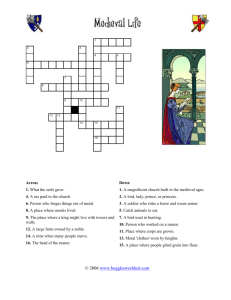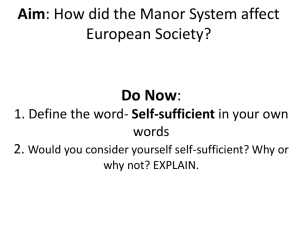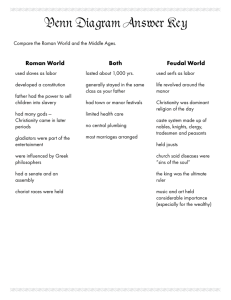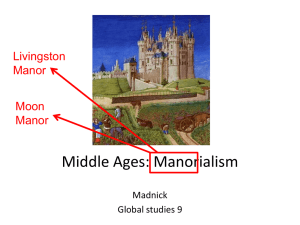Manor New Technology High School
advertisement
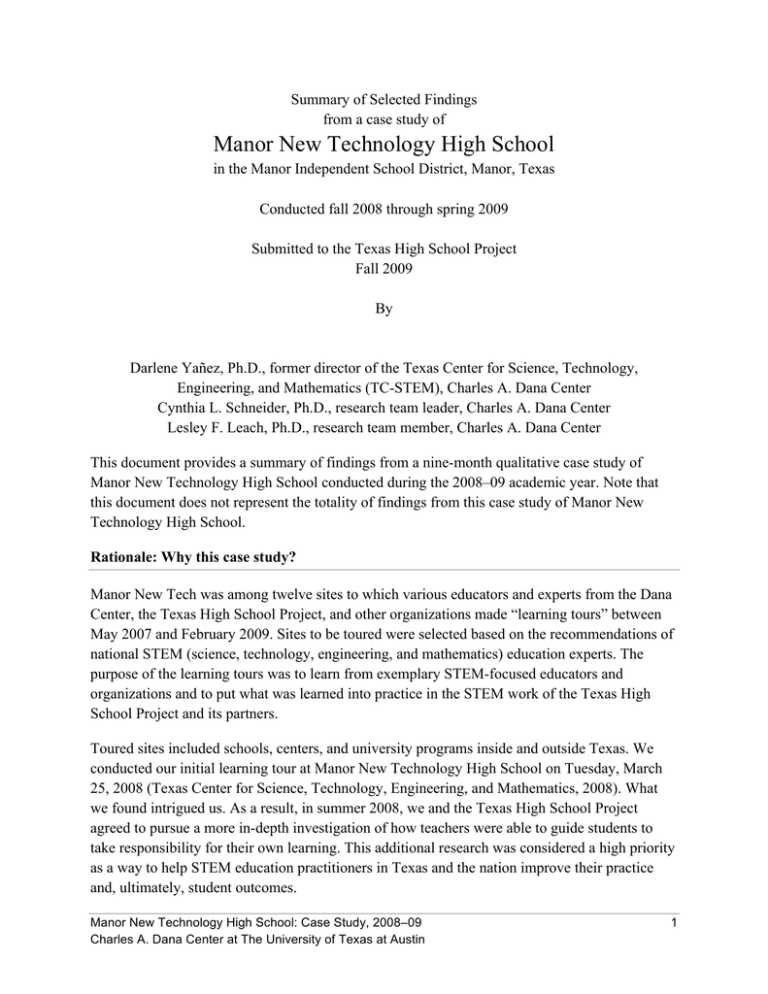
Summary of Selected Findings from a case study of Manor New Technology High School in the Manor Independent School District, Manor, Texas Conducted fall 2008 through spring 2009 Submitted to the Texas High School Project Fall 2009 By Darlene Yañez, Ph.D., former director of the Texas Center for Science, Technology, Engineering, and Mathematics (TC-STEM), Charles A. Dana Center Cynthia L. Schneider, Ph.D., research team leader, Charles A. Dana Center Lesley F. Leach, Ph.D., research team member, Charles A. Dana Center This document provides a summary of findings from a nine-month qualitative case study of Manor New Technology High School conducted during the 2008–09 academic year. Note that this document does not represent the totality of findings from this case study of Manor New Technology High School. Rationale: Why this case study? Manor New Tech was among twelve sites to which various educators and experts from the Dana Center, the Texas High School Project, and other organizations made “learning tours” between May 2007 and February 2009. Sites to be toured were selected based on the recommendations of national STEM (science, technology, engineering, and mathematics) education experts. The purpose of the learning tours was to learn from exemplary STEM-focused educators and organizations and to put what was learned into practice in the STEM work of the Texas High School Project and its partners. Toured sites included schools, centers, and university programs inside and outside Texas. We conducted our initial learning tour at Manor New Technology High School on Tuesday, March 25, 2008 (Texas Center for Science, Technology, Engineering, and Mathematics, 2008). What we found intrigued us. As a result, in summer 2008, we and the Texas High School Project agreed to pursue a more in-depth investigation of how teachers were able to guide students to take responsibility for their own learning. This additional research was considered a high priority as a way to help STEM education practitioners in Texas and the nation improve their practice and, ultimately, student outcomes. Manor New Technology High School: Case Study, 2008–09 Charles A. Dana Center at The University of Texas at Austin 1 Background Manor New Tech opened its doors in 2007 as one of the official Texas Science, Technology, Engineering, and Mathematics (T-STEM) Academies of the Texas High School Project. The school is in Manor, Texas, just outside the Austin city limits and about 12 miles east of the University of Texas at Austin main campus. In 2000, the U.S. Census documented Manor’s population at 1,204 (U.S. Census Bureau, n.d.). Since that time, Manor has grown significantly, with the Greater Manor Chamber of Commerce (n.d.) reporting a population of 5,468 as of December 2006. Since 2003, the Manor Independent School District has also grown, with the district’s 2008–09 student enrollment at 6,222. Manor district students live in the city of Manor, in the rural community surrounding Manor, or in a specific area within the city limits of Austin. Manor New Tech is one of two high schools in Manor Independent School District. When it opened in 2007, Manor New Technology High School had 157 students in ninth and tenth grade. The school added a grade each of the next two subsequent years. For the 2009–2010 school year, Manor New Tech High will serve 315 total students in grades nine through twelve. Of those, about 44% are Hispanic, 32% are White, 22% African American, and 2% of Asian ethnicity. About 56% of Manor New Tech’s students are considered to be economically disadvantaged, and 5% participate in special education programs. In 2008–09, the school had three English language arts teachers, three mathematics teachers, five science teachers, and three social studies teachers, as well as three technology teachers, three engineering teachers, one Spanish language teacher, and one Physical Education teacher. Most classes presented integrated content—for example, Algebra II and Physics or English language arts and History—so most classes were also team taught by the subject matter experts for each field. Manor New Tech uses the New Tech Network’s school model, which has three major components: (a) use of a project-based learning instructional approach to offer engaging, collaborative opportunities for learning, (b) use of technology integrated across the curriculum, and (c) creation of a school culture that is based on “trust, respect, and responsibility” (New Tech Network, n.d.). During our March 2008 learning tour of the school we observed that The student-to-computer ratio is one-to-one, which enables creative presentations, research, and communication. Students apply their knowledge through team projects, modeling real-life work situations, job assignments, internships, peer reviews, and Manor New Technology High School: Case Study, 2008–09 Charles A. Dana Center at The University of Texas at Austin 2 connections to community, college, and career experiences. They are free to express creativity, knowledge, skills, and initiative. Collaboration among administrators, teachers, and students is core to the culture of the school. Principal Steven Zipkes noted, “everyone in the school has a leadership role” (Texas Center for Science, Technology, Engineering, and Mathematics, 2008, p. 1). Since that time, Manor New Tech has also implemented The Teacher Advancement Program. This program offers teachers opportunities for professional growth and advancement in the classroom using a coaching model for ongoing support and reflection. In 2009, Manor New Tech High was identified by Apple representatives as one of only 33 Apple Distinguished Schools in the nation. This honor was awarded because of the school‘s “demonstrated success in implementing a 21st-century learning environment” (PRNewswireUSNewswire, 2009, p. 1) that focused on technology, innovation, and life and career skills. Summary of methodology As Manor New Tech High’s accomplishments continued to make state and national news, researchers at the Charles A. Dana Center at the University of Texas at Austin embarked on a nine-month qualitative case study of the school. The initial purpose of the case study was to determine the practices used at Manor New Tech that supported students in taking responsibility for their own learning. It is important to note that unlike quantitative analyses, qualitative research does not set out to accept or reject a specific hypothesis. In addition, qualitative research can be considered to be emergent research, meaning that it is driven by an ongoing evaluation of the data—and that evaluation of the data may change the research questions, purpose, methods, or other portions of a study while the study is underway (Hatch, 2002). This emergent model of qualitative research was used in the present study. Two Dana Center researchers spent about 20 days during the 2008–09 school year visiting classrooms, observing teacher meetings, and interviewing staff members and students at Manor New Tech. All twenty-two teachers were interviewed individually, and about 5% of the school’s students participated in focus-group interviews. Over the course of this school year, we collected about 200 pages of notes, which we finished coding and analyzing in summer 2009. (Copies of the observation and interview protocols are available upon request.) Manor New Technology High School: Case Study, 2008–09 Charles A. Dana Center at The University of Texas at Austin 3 Summary of findings Two themes emerged from our observations of Manor New Tech in 2008–09—the presence of a supportive school culture and of high levels of student engagement. What we found with regard to these themes suggests that they positively affect students’ abilities to take responsibility for their own learning. Because the New Tech Network’s (n.d.) school model includes both a supportive school culture (one based on “trust, respect, and responsibility”) and a high level of student engagement through its use of project-based learning strategies, we concluded that the school’s adherence to these components of the New Tech Network’s school model was an essential element of the school milieu in which Manor New Tech students learned to take responsibility for their own learning. In this report, we detail some of the data that support these themes and explore how these themes might contribute to the building over time of students taking responsibility for their learning. It is important to note, however, that this report does not attempt to identify all factors that could contribute to changes in levels of students’ individual responsibility, but rather summarizes only a few of the relevant factors that emerged in our case study at Manor New Tech High. School Culture The culture of Manor New Tech emerged from the research data as a predominant factor in motivating and supporting teachers and students. Trust Over the course of ten months (August 2008 to May 2009), we found the central element of this school’s culture to be trust, which, as we observed it at Manor New Tech, could be described as “a product of everyday interactions that affect person-to-person relationships in the school” (Kochanek, 2005, p.6). Once trust is established between individuals—and, in the example of Manor New Tech, these individuals are educators (the teachers and administrators) and students—trust becomes part of the school culture and affects the structural characteristics1 of the school. Research has shown a positive relationship between the degree of trust among administrators, teachers, and students at a school and the degree to which the school’s academic achievement improves from year to year (Bryk & Schneider, 2002). In other words, schools like Manor New Tech High that foster trust among students, teachers, and administrators are likely to see greater 1 In this context, structures are considered to be practices that affect the management and performance of individuals on a campus, such as schedules, group facilitation tools, school policies, or other practices that integrally affect the work of the school. Manor New Technology High School: Case Study, 2008–09 Charles A. Dana Center at The University of Texas at Austin 4 improvement in measures of academic achievement than schools that do not foster trust among school members or that foster trust to a lesser degree. Manor New Tech has designed a personalized learning environment that builds on trust. When asked what makes Manor New Tech unique, one of the teachers said, “We are in the business of building relationships: teacher–student relationships, student–student relationships, and teacher– teacher relationships.” One teacher commented on teacher–student relationships, “Kids don’t pay attention and learn because of consequences. They need for you [the teacher] to show your humanity, and they [students] will trust you. I know them as people, not just students, and that is critical for learning.” Another teacher commented, “There is no fear in this [teacher and student] relationship—only trust and respect for each other—and this translates to shared excitement for learning.” In fact, each of the teachers interviewed mentioned that trust must be present in a classroom and in a school for teaching and learning to occur. The students’ comments mirrored the teachers’ explanations about relationships and trust. One focus group of ninth-, tenth-, and eleventh-grade students said that the culture at Manor New Tech is different from that of the other high school in Manor ISD. One of the students explained, “The relationship between students and teachers is different here; it feels different here. The teachers care about me—they care about all of us, and that makes me want to do the best I can.” Students described their teachers as mentors, facilitators, and guides. And students repeatedly said that teachers at Manor New Tech were very smart and worked very hard and that “they care.” One of the students we interviewed said, “…high school is different at the regular high school. Students are a statistical sample; they fall into data categories. Here we are people, and our teachers let us ask questions and talk to them. They are here for us.” Critical Friends We identified one particular structural characteristic of Manor New Tech High that supports relationship building and fosters trust between teachers and students, teachers and teachers, and administrators and teachers. Manor New Tech teachers use a program known as Critical Friends Groups to foster trust and improve their teaching practices. There are two such groups at Manor New Tech; each is made up of about 11 members that routinely—and voluntarily—come together to talk about teaching and learning. The groups are designed to promote honest conversations that elicit feedback from other members; these conversations can lead to improved teaching practices among members and, ultimately, greater student achievement (Bambino, 2002; National School Reform Faculty at the Harmony Education Center, n.d.). During the 2008–09 school year, we observed the Critical Friends Group forum in action. It was used to discuss the launch of projects, debate controversial topics, and reflect on student–teacher interactions. These groups gave teachers a safe environment in which to ask questions and reflect professionally about content and pedagogy as well as school policy and rules. In addition, teachers modeled use of the Critical Friends protocol—particularly the critical questioning and Manor New Technology High School: Case Study, 2008–09 Charles A. Dana Center at The University of Texas at Austin 5 feedback portions—for students in their classrooms to, as one teacher noted, “…model for students how to ask questions.” Based on observations and interviews with teachers, we concluded that the Critical Friends protocol was an essential structural characteristic in establishing and facilitating trust between teachers. Undoubtedly, the Critical Friends Groups added to the culture of support at Manor New Tech. Moreover, these groups’ interactions likely also played a role in improving the instructional program by highlighting concerns with lessons and projects before and/or after they were implemented in the classroom. No Fear Several teachers commented that, after some time at Manor New Tech, students seemed to demonstrate less fear in pursuing their learning goals. One teacher noted, “Sometimes students have to fall and learn to pick themselves back up. We need to let students learn to be leaders. Sometimes we are afraid the kids will drop the ball, but we have to let them try—it’s a balancing act for teachers to just let go.” This learning without fear, which is fostered through the relationship building that takes place every day in every classroom, appears to enable student engagement. Because of the trust shared between teachers and students, students are willing to take risks. This finding illustrates yet another important result of the supportive school culture— the absence of fear—that enables student engagement with other students and teachers in collaborative learning projects. The two coteachers echoed each other’s comments during the interview: “Our job is to be futurists and see what kids will need. We need to show them how to teach themselves without fear. We give them a basic set of tools and then they can apply these tools to anything and add to their toolset using the Internet or any other kind of technology they find. They [students] become learners and teachers at the same time.” When asked to elaborate on the phrase “teach themselves without fear,” teachers provided a clear explanation—they said that real learning is uncomfortable and that it was the responsibility of the classroom teachers to allow kids to experience that “uncomfortableness” with support. Building trust through relationships, engaging the community—both teachers and students—in asking relevant questions (for example, through the Critical Friends Groups), and creating an environment of no fear all contributed to establishing a school culture at Manor New Tech that is not found on many traditional high school campuses. It is not clear from this emergent research if the culture alone is a necessary and a sufficient condition to influence students’ willingness to take responsibility for their own learning. But the elements of school culture described here appear to be important in creating a supportive environment in which students can take risks— including risks such as taking responsibility for their own learning. Manor New Technology High School: Case Study, 2008–09 Charles A. Dana Center at The University of Texas at Austin 6 Student Engagement Student engagement also emerged from the research data as a critical factor in enabling students to take responsibility for their own learning. Project-based learning Student engagement is supported by another structural characteristic of Manor New Tech: its use of project-based learning. Throughout the school day, the researchers observed that students were not passively receiving—but were in fact actively engaged in—learning, both independently and in small groups. In every classroom observation, researchers saw students interacting with one another, with the computer, or with their teachers. The researchers observed only minimal direct instruction—ranging from five to twenty minutes of a ninety-minute class period—to small groups and whole classrooms. When not involved with direct instruction, teachers moved among groups of students, making suggestions and comments and answering student questions regarding content. Throughout the process, teachers and students consistently referred to assessment rubrics to guide students to successful completion of assigned projects. One student commented on this learning process: “We learn our content based on our questions and research. We don’t learn from a single person or worksheet or book or lecture.” Student engagement is a necessary component and a classic outcome of well-implemented project-based learning. In fact, the Buck Institute for Education2 (2003) defines project-based learning as “a systematic teaching method that engages students in learning knowledge and skills through an extended inquiry process structured around complex, authentic questions, and carefully designed products and tasks” (p. 4). Teachers facilitate the development of projects through interaction with students and with input from the teachers’ Critical Friends Groups. This input is critical, because projects must be carefully designed to meet content standards3 across several disciplines and still pique student interest. One teacher, commenting on the school’s project-based approach, noted that, “The kids come up with so many ideas and want to do very challenging projects; we have to figure out how to do it—that’s why we have to continue to expand our own personal professional development.” At the project launch, students are given a scenario of the project along with the specific content standards that the project must address. Students also receive their materials, timelines/calendars, and assessment rubrics. Once students have reviewed these initial project materials, they are asked to determine—individually or as a project group—what they already know about the 2 According to their website, the Buck Institute for Education is a nonprofit that works to improve the effectiveness of schools and classrooms through problem- and project-based learning. 3 Texas’s state education standards are the Texas Essential Knowledge and Skills, or TEKS. Manor New Technology High School: Case Study, 2008–09 Charles A. Dana Center at The University of Texas at Austin 7 project topic as well as what they need to know. The students then return to a whole-class setting where the teacher and students review the know/need-to-know lists and clarify questions and answers about the project. Student groups then apply their knowledge of the content— mathematics, science, social studies, and/or English—to carrying out the specific projects that had been framed for them by their teachers. We observed each student project team taking different approaches to completing their projects, even though the learning goals and expectations were the same for all teams. In addition, students enjoyed extensive creative license in the design of their final products. Every student group had a designated leader, and each team member received a work ethic grade as one of the many grades given during a project. One of the teachers said, “The essence of PBL [project-based learning] is students being responsible for their own learning. We build structures for them to use and turn them loose—students identify what they don’t know, and they go for it. Students find out what they need to know using any and all tools, including each other.” Students become responsible to their group for their portion of the project, but students have to know each other’s work as well. Using strategies from Critical Friends Groups, teachers model the practice of collaboration for students. This modeling of Critical Friends Group techniques may be especially important to successful project-based learning at Manor New Tech, particularly in the ways the CFG protocols relate to questioning. For example, many of the teachers that we interviewed indicated that students entering the school for the first time had little understanding of inquiry and often had difficulty formulating effective questions. One of the teachers stated during the interview, “When students first come here, they do not have any questioning skills. Kids have to keep asking questions until it makes sense… but sometimes they do not have the skills to ask questions to get to what they just don’t know or understand.” During the project launch, the entry document requires that students create questions about what they know and do not know about the topic. This creation is done using the Know and Need-to-Know format, a protocol with which Manor New Tech teachers have become experts. One of the coteacher teams discussed this protocol during an interview: We’ve learned a lot about knows and need-to-knows. We found out that most of the kids understood how to ask questions about logistics of the project like when is it due, will we be using any technology, how many grades will we get, etc. However, substantive content questions were lacking. So, we created another column in our protocol that covers content. Kids began asking need-to-know questions about content; they were beginning to use inquiry. It has been amazing! Students reportedly master the project launch protocols fairly quickly. In fact, teachers with two or more years of experience at Manor New Tech indicated that most students know how to use the launch protocol skills by the end of their freshman year. Teachers with sophomores and Manor New Technology High School: Case Study, 2008–09 Charles A. Dana Center at The University of Texas at Austin 8 juniors during the 2008–09 school year stated that the sophistication of the questions that students ask—at project launch and throughout—has dramatically improved since the students were freshmen. When we interviewed students about their projects, they spoke about the project launch materials—including the Texas Essential Knowledge and Skills statements that the project was designed to address. Surprisingly, it was the first time that one long-time Texas researcher had heard students discussing elements of the TEKS. Second-year students at Manor New Tech were familiar with the TEKS and understood the necessity of mastering the concepts and content the TEKS described. One of the teachers stated that by the time students are in their second year of project-based learning, “Students take the initiative to create questions and they will search for the answers to the questions—which leads them to discovery.” Project-based learning is not simply cooperative learning with a project attached. It is a genuine example of workplace collaboration. One of the students said, “Everyone pushes everyone to do better and more.” When a student is absent during a project presentation, the project group must take over for the absent member. As a result, every group member is held responsible for understanding the content described in the relevant TEKS—not just the person assigned that piece of the project. Furthermore, no member of the team is exempt from review panel questions during their group’s project presentation, so collaboration and equal participation from all group members is essential. One comment from a teacher captures what most teachers said: “PBL means that students are motivated from the get-go.” At the beginning of each project, students sign an agreement with the other students in the group and with the teacher. If a student is not doing his portion of the project, it is the responsibility of the project team members to bring this to the attention of the teacher—being specific about the responsibilities that are not being completed. While rarely necessary, a possible consequence for a student proven to not be working with his or her group would be to complete the entire project on his or her own. Students attempted to provide support for their peers, but teachers monitored the groups on a regular basis to be sure they were functioning as intended and that no lone student or set of students was carrying the load for the whole group. Rather than fostering internal conflict or sniping, the supportive environment contributes to students and teachers trying to work out ways for all students to be successful. When asked how they were able to make students accountable for their own learning, the majority of the teachers interviewed said that project-based learning and assessment rubrics were key. At the beginning of each project, students are given the assessment rubric for that project. This rubric details the criteria by which each element of the final project will be assessed. For example, a report may be produced as a podcast rather than as a paper. If so, rubric specifies a minimum length for the podcast, as well as the report topic and what elements the report must include (such as an introduction and a conclusion). Teachers also provide students with Manor New Technology High School: Case Study, 2008–09 Charles A. Dana Center at The University of Texas at Austin 9 exemplars for final products. Usually, teachers also give benchmark grades as key stages of the project are completed. One teacher said, “We [teachers and students] are more equal here in terms of [being] learners than [in] traditional schools. We [the teachers] know that we do not know it all, and we are creating knowledge with the kids.” At Manor New Tech, students are given the latitude to explore, discover and create. From the researchers’ interviews with teachers, it would appear that the teachers know why and how they should support this learning. None of the students interviewed said that Manor New Tech was easier than a traditional high school; in fact, they seemed to agree that students actually have to be more responsible to get their work done. Without exception, all the students we interviewed stated that the most difficult adjustment to make when they began attending Manor New Tech was time management. Students reported the need to discipline themselves to be more efficient with their time and to work productively with fellow students. And each of the students that we interviewed noted a particular teacher who had helped him or her learn how to use time well and collaborate effectively with others. Conclusion Our analysis of the data we collected for the 2008–2009 school year suggests that Manor New Technology High School has successfully implemented the New Tech Network’s model. At the heart of this model is the use of project-based learning strategies enhanced with technology and supported by a school culture based on (in the phrasing of the Network) “trust, respect, and responsibility.” There are many school reform models out there. Too often, schools adopt a model but never implement it with fidelity. While it was not the intent of this research to investigate how well the New Tech Network model was implemented, the two themes that emerged from student and teacher comments and actions during our interviews and observations—a supportive school culture and high levels of student engagement—point toward fidelity of implementation. When implemented with fidelity, the New Tech model supports students in taking responsibility for their own learning. Key elements of the model that support students taking such responsibility are • the use of project-based learning and • the creation of a school culture that fosters trust and strong teacher–student relationships. Manor New Technology High School’s use of the New Tech Network’s project-based learning strategies increases the likelihood of productive student engagement. At Manor New Tech, project-based learning is supported with well-thought-out protocols such as know and need-toManor New Technology High School: Case Study, 2008–09 Charles A. Dana Center at The University of Texas at Austin 10 know questioning and assessment rubrics. Teachers and students vet project ideas in the context of the Critical Friends Group process, and student group dynamics are constantly monitored for effectiveness by teachers as well as by the students themselves. A school culture based on trust is a well-known component of successful schools (Ragland et al., 2000). Creating a culture of trust in a school takes concerted effort, as trust does not develop by chance. Providing opportunities for teachers to meet regularly and follow a research-based protocol such as the Critical Friends Groups has worked for Manor New Tech. Both students and teachers are viewed as learners. Teachers use the tools they learn from their own work in designing projects and in working with their students to complete projects in the classroom. There is little fear of failure in this climate of exploration and learning. In sum, during our observations, we saw students taking responsibility for their own learning in multiple ways—in their commitment to accomplishing tasks for a project, their self-direction in joining in-class workshops on specific topics, and their monitoring of group roles and responsibilities. Research (e.g., Zimmerman, 2002) has shown that self-regulated learners are “not only more likely to succeed academically but to view their futures optimistically.” What we heard and observed at Manor New Technology High School bears out this finding. Manor New Technology High School: Case Study, 2008–09 Charles A. Dana Center at The University of Texas at Austin 11 References Bambino, D. (2002). Critical friends. Educational Leadership, 59(6), 25–27. Bryk, A. S., & Schneider, B. (2002). Trust in schools: A core resource for improvement. New York: Russell Sage Foundation. Buck Institute for Education. (2003). Project based learning handbook: A guide to standardsfocused project based learning for middle and high school teachers. Novato, CA: Author. Greater Manor Chamber of Commerce. (n.d.). Community and growth. Retrieved October 6, 2009, from www.manorchamberofcommerce.com/relocation/community.php. Hatch, J.A. (2002). Doing qualitative research in educational settings. Albany, NY: State University of New York Press. Kochanek, J.R. (2005). Building trust for better schools: Research-based practices. Thousand Oaks, CA: Corwin Press National School Reform Faculty at the Harmony Education Center. (n.d.). Frequently asked questions (FAQ). Retrieved October 5, 2009, from www.nsrfharmony.org/faq.html#1. New Tech Network (n.d.). About us. Retrieved October 8, 2009, from www.newtechfoundation.org/about.html. PRNewswire-USNewswire. (2009, April 23). Manor New Technology High School joins elite group of Apple Distinguished Schools: Innovative high school outperforms state averages in all key subject areas. Retrieved September 29, 2009, from www.redorbit.com/news/technology/1676624/manor_new_technology_high_school_join s_elite_group_of_apple/ Ragland, M., Clubine, B., Knight, D. L., Schneider, C. L., and Smith, P. A. (2000). Opening doors: Promising lessons from five Texas high schools. Austin: Charles A. Dana Center at The University of Texas at Austin. Texas Center for Science, Technology, Engineering, and Mathematics. (2008, March 25). Learning tour: Manor New Technology High School. Retrieved October 6, 2009 from www.utdanacenter.org/tcstem/manornths.php. U.S. Census Bureau. (n.d.). Retrieved October 6, 2009, from factfinder.census.gov/servlet/SAFFFacts?_event=Search&geo_id=&_geoContext=&_stre et=&_county=manor&_cityTown=manor&_state=04000US48&_zip=&_lang=en&_sse= on&pctxt=fph&pgsl=010&show_2003_tab=&redirect=Y. Zimmerman, B.J. (2002). Becoming a self-regulated learner. Theory into Practice. 41(2), 64–70. Manor New Technology High School: Case Study, 2008–09 Charles A. Dana Center at The University of Texas at Austin 12
